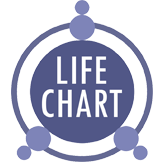Centers
In the Human Design system, each of the 9 centers in your bodygraph can be classified as either defined or open (or partially open). This distinction is crucial as it reveals how energy circulates in your body and how you connect with the world. Additionally, the concept of completely open centers adds another layer of understanding to your Human Design chart.
Defined Centers: Stability and Self-Expression
Consistency and Reliability: Defined centers (shown in color on the chart) serve as sources of stable, consistent energy. Individuals with defined centers exhibit enduring energetic patterns in these areas, which remain unchanged regardless of external circumstances. These centers contribute to stable personality traits and behaviors.
Strength and Confidence: Within these centers, a person is acutely aware of their qualities and expresses them with confidence. The energy in these centers operates independently of outside influences, allowing individuals to trust their reactions and decisions in relevant life areas. For example, someone with a defined emotional center can experience their feelings with deep inner assurance and express them openly.
Independence: Defined centers are not swayed by external energies and are less affected by the people around them. Those with defined centers typically experience less external influence in the realms governed by these centers.
Clear Expression: People with defined centers display consistent behavior patterns that are easy to identify. Their traits are clearly defined, and their approaches to problem-solving in these areas are predictable and stable.
Open Centers: Flexibility and Sensitivity
Fluid and Variable Energy: Open centers (uncolored in the bodygraph) lack stable, consistent energy. They absorb energy from the outside world, making them highly adaptable and sensitive to environmental changes. Energy in these centers is activated only through interactions with others or external situations.
Sensitivity to External Influences: Individuals with open centers are often strongly affected by those around them. They tend to absorb the energies of people nearby, leading to fluctuations in their own expressions. For instance, a person with an open emotional center may experience mood swings influenced by the emotions of others.
Reflection and Adaptation: Open centers act as mirrors, reflecting the energy that enters from the outside. As a result, people with open centers often possess a remarkable ability to adapt to various situations and environments. This can be both a gift and a challenge, as they are susceptible to the beliefs, emotions, and energetic states of others.
Potential for Growth and Learning: Open centers represent areas where individuals learn and grow through their interactions with the world. These centers allow for greater receptivity and openness to new knowledge and experiences. However, it is essential to resist external pressures and avoid conforming to others’ expectations, which can lead to discomfort.
Completely Open Centers: Extreme Sensitivity
Completely open centers are those without any activations or hanging gates. These centers are the most sensitive to external energies, and their influence on a person’s life is unique:
Pure Perception: Completely open centers function like a blank canvas, projecting the energies of the surrounding world. A person with such a center not only perceives the energies of others but amplifies them, reflecting them back into the environment. This can lead to significant external influence, where individuals absorb the emotions, thoughts, or behaviors of those around them.
Lack of Consistency: Unlike defined centers that provide stable energy, completely open centers lack a solid foundation. They operate solely based on the presence of others, making these centers unpredictable and variable. A person with such a center may feel lost if they do not recognize their sensitivity.
Temptation to Mimic Others: One of the greatest pitfalls for those with completely open centers is the urge to conform to others and adopt their qualities as their own. They may try to mimic the behaviors of those around them to feel more grounded. This can create confusion and difficulties in finding their identity.
Potential for Wisdom: However, if a person with completely open centers recognizes their sensitivity and learns to navigate external energies, they can gain immense wisdom. Such individuals are capable of observing surrounding processes objectively and developing a deep understanding of people and situations.
The Impact of Defined and Open Centers on Life
Open centers make a person more receptive to the world and those around them but can lead to seeking external validation and the desire to meet expectations.
Defined centers provide stability and confidence, creating consistent behavioral and energetic patterns that help individuals express themselves independently of outside influences.
Completely open centers carry a unique vulnerability but can also be a source of great potential and deep wisdom if one learns to recognize and direct their perception.
Understanding which centers are defined and which are open helps individuals better navigate their Human Design chart and build their lives based on these insights.

